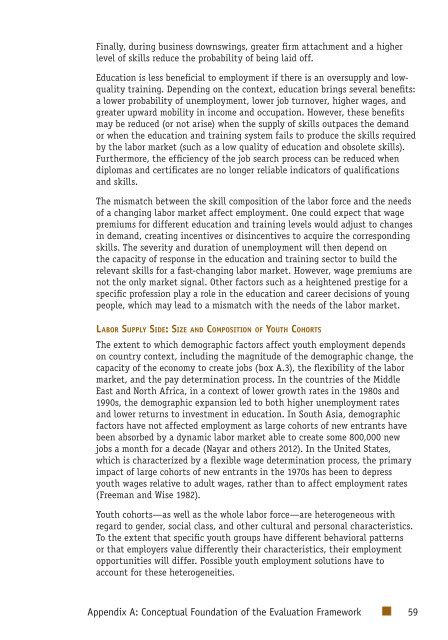Youth Employment Programs - Independent Evaluation Group
Youth Employment Programs - Independent Evaluation Group
Youth Employment Programs - Independent Evaluation Group
Create successful ePaper yourself
Turn your PDF publications into a flip-book with our unique Google optimized e-Paper software.
Finally, during business downswings, greater firm attachment and a higherlevel of skills reduce the probability of being laid off.Education is less beneficial to employment if there is an oversupply and lowqualitytraining. Depending on the context, education brings several benefits:a lower probability of unemployment, lower job turnover, higher wages, andgreater upward mobility in income and occupation. However, these benefitsmay be reduced (or not arise) when the supply of skills outpaces the demandor when the education and training system fails to produce the skills requiredby the labor market (such as a low quality of education and obsolete skills).Furthermore, the efficiency of the job search process can be reduced whendiplomas and certificates are no longer reliable indicators of qualificationsand skills.The mismatch between the skill composition of the labor force and the needsof a changing labor market affect employment. One could expect that wagepremiums for different education and training levels would adjust to changesin demand, creating incentives or disincentives to acquire the correspondingskills. The severity and duration of unemployment will then depend onthe capacity of response in the education and training sector to build therelevant skills for a fast-changing labor market. However, wage premiums arenot the only market signal. Other factors such as a heightened prestige for aspecific profession play a role in the education and career decisions of youngpeople, which may lead to a mismatch with the needs of the labor market.Labor Supply Side: Size and Composition of <strong>Youth</strong> CohortsThe extent to which demographic factors affect youth employment dependson country context, including the magnitude of the demographic change, thecapacity of the economy to create jobs (box A.3), the flexibility of the labormarket, and the pay determination process. In the countries of the MiddleEast and North Africa, in a context of lower growth rates in the 1980s and1990s, the demographic expansion led to both higher unemployment ratesand lower returns to investment in education. In South Asia, demographicfactors have not affected employment as large cohorts of new entrants havebeen absorbed by a dynamic labor market able to create some 800,000 newjobs a month for a decade (Nayar and others 2012). In the United States,which is characterized by a flexible wage determination process, the primaryimpact of large cohorts of new entrants in the 1970s has been to depressyouth wages relative to adult wages, rather than to affect employment rates(Freeman and Wise 1982).<strong>Youth</strong> cohorts—as well as the whole labor force—are heterogeneous withregard to gender, social class, and other cultural and personal characteristics.To the extent that specific youth groups have different behavioral patternsor that employers value differently their characteristics, their employmentopportunities will differ. Possible youth employment solutions have toaccount for these heterogeneities.Appendix A: Conceptual Foundation of the <strong>Evaluation</strong> Framework 59
















